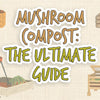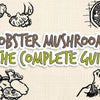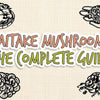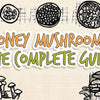Portabella Mushrooms: The Complete Guide
An infamous mushroom in the 1980s that has now become one of the most popular mushrooms across the globe? Portabella mushrooms, also known as portobello mushrooms, are as intriguing as they are delicious and popular. Less than four decades ago, the mushroom was thought to be a species on its own until research showed that portabellas are actually mature creminis.
In this guide, we will uncover this unique type of mushroom and explore their health benefits, where to find them, how to grow them, what to do with them once you have them, and how to prepare or preserve them.
Warning: Portabella mushrooms should never be consumed raw. Research shows that portabella mushrooms contain agaritine and hydrazine compounds that are cancer causatives (link).
Not Much Time? Skip To What You'd Like To Learn...
-
Five Portabella Mushroom Facts!
-
Is it Portobello or Portabella Mushrooms?
-
Top 5 Benefits of Portabella Mushroom
-
Portabella Mushrooms in a Ketogenic Diet
-
What To Look For When Buying Portabella Mushrooms?
-
Identifying Portabella Look-Alikes
-
Foraging For Portabella Mushrooms
-
Growing Portabella Mushrooms at Home
-
Harvesting Portabellas
-
How To Clean Your Portabellas
-
Preserving Portabella Mushrooms
-
Portabella Mushroom Recipes
Five Portabella Mushroom Facts!
-
Portabellas are mature cremini and button mushrooms
-
They are the most consumed and cultivated mushroom species in the world
-
They were largely unfavored until the name was changed in the 1980s
-
Portabellas grow all year long in different kinds of environments
-
They are commonly used in pizzas and burgers
Is it Portobello or Portabella Mushrooms?

The correct way of writing and pronouncing this mushroom's name caused intense online debate. Before the 80s, the mushroom remained largely unfavored, which triggered farmers to coin a name to boost its market popularity. Nobody really knows where the motivation of the name originated. According to online opinions, the mushroom's name comes from:
-
The Portobello Road (London), which contains high-end fashion shops
-
Porto Bello (Panama), a port captured by the British from the Spanish in 1739
-
The Portobello TV Show
Top 5 Benefits of Portabella Mushrooms

Anti-Cancer Properties - Portabella mushrooms contain numerous nutrients and compounds like beta-glucans, grifolin, lentinan, and lectins. Which are scientifically proven to inhibit the formation of cancerous cells.
Portabellas also contain phytochemicals like CLA, which according to studies, helps to inhibit cell proliferation, induce apoptosis (cell death), and lipid metabolism (link).
Research conducted on mice found that those administered with portabella mushroom extract showed a significant reduction in prostate tumor size and proliferation of tumor cells (link).
A recent Brazilian study also determined that the beta-glucans in the mushroom help in fighting liver cancer (link).
Prevents Migraines and Headaches - Portabella mushrooms contain riboflavin, a source of vitamin B2, which helps reduce migraines and headaches. Studies have shown that foods rich in vitamin B2 can cure a wide array of diseases including pain relief caused by acute headaches and migraines. Vitamin B intake also increases cognitive ability, lowers effects of stress on the body and helps in controlling cholesterol and blood pressure levels (link).
Promotes Blood Health - Copper plays a major role in the formation of hemoglobin and red blood cells, which is important for respiration. Cooper also aids during tissue repair, promotes a healthy metabolism, helps prevent fatigue, and catalyzes the molecular breakdown of oxygen to produce energy. Portabella mushrooms contain high traces of copper and selenium. Research shows that selenium helps in controlling the thyroid function in the body, which prevents cases of hyperactive and hypothyroidism (link). Portabella mushrooms contain up to 30% selenium that helps reduce the effects of depression and anxiety by promoting hormone activity and overall body health (link).
Healthy Bone and Nerve Development - Potassium helps in calcium absorption and bone density and function and promotes overall bone health. Studies show that portabella mushrooms are a rich source of the mineral. The body also requires potassium to develop a healthy nervous system and potassium ions are important to ensure healthy neuron activity and brain function (link). 2 servings of portabella mushrooms contain up to 600 milligrams potassium, which is about 13 percent of your daily needs (link). Studies also confirm that potassium is essential during renal activities especially in the reabsorption of essential minerals, which shows just how beneficial portabella mushrooms are in promoting a healthy lifestyle.
Rich Anti-Inflammatory Properties - Portabellas are a rich source of antioxidants and contain natural anti-inflammatory properties. Rich in fiber and low in calories, portabella mushrooms also have L-ergothioneine (ERGO) which are important for fighting against inflammation in the body (link). Fungi and certain varieties of bacteria can make ERGO and portabella mushrooms form some of the few rich food sources available (link). ERGO also helps in counteracting diseases such as Parkinson's disease and other red blood cells disorders (link).
Portabella Mushrooms in a Ketogenic Diet

Mushrooms, particularly portabellas, are an excellent source of low carb protein that does not come from animals with only 15 calories, 2.3 gram of carbohydrate (link), and a small amount of fat. So yes! You can enjoy portabella mushrooms while on a ketogenic diet and because of their taste and meaty textures form a good alternative to meats and other sources of protein. Rich in fiber and essential nutrients, portabella mushrooms promote muscle growth and form an excellent protein source for those on a ketogenic diet (link).
What To Look For When Buying Portabella Mushrooms?
Smell: Fresh portabellas should produce a rich earthy smell.
Sight: Fresh mushrooms are large with a light-dark brown pigment, they have a flat cap at the bottom roughly 15 centimeters in diameter (link). Underneath the cap are dark-brown gills that form a strong fibrous stem.
Touch: Fresh portabellas are damp and spongy with a smooth cap whereas dried ones are firm to touch.
When bad, portabellas develop a sticky surface and darken in color. Fresh whole mushrooms last longer with a shelf life of a week. Dried mushrooms have a shelf life of two years (link).
Identifying Portabella Look-Alikes
Mushrooms are fungi and have a lot of species and subspecies, some are edible and others are completely toxic. You should take care to ensure that you have enough knowledge of your mushrooms before you go foraging.
Cremini Mushrooms - These occur as a younger version of portabellas. The mushrooms are edible and quite common in stews and cuisines. They are a dark brown color with firm stems. These mushrooms are larger than white button mushrooms but smaller than portabellas. Creminis share a similar flavor to the white button but not as meaty as the portabellas (link).
White button mushrooms - A member of the same species as the portabellas, the mushrooms have a distinct white color. White button mushrooms are relatively cheap, which makes them some of the most common mushrooms consumed across the globe. White button mushrooms contain a milky white pigmentation, with smaller heads compared to portabellas.
For a comprehensive guide to button mushrooms, check out our article here (link).
Yellow stainer mushroom - Portabella mushrooms, which have a scientific name agaricus bisporus, has a relation with the poisonous yellow stainer mushroom agaricus phenolic. Both look similar which is confusing to the eye, this makes them some of the most commonly consumed poisonous mushrooms (link). These mushrooms have large caps with long dense stems. Sometimes reaching 15 cm. When sliced, the flesh bruises turn yellow and emits a pungent smell (link).
Foraging For Portabella Mushrooms

When foraging we would always recommend using mushroom knife for ease of use, and a clean cut. Interested in learning more about mushroom knives? Click Here For The Complete Guide To Mushroom Knives
Portabellas take approximately 14 days to grow. You get creminis in the first couple of days that grow into portabellas a week later. This makes foraging for portabellas fairly easy compared to other mushrooms. You only have to identify where creminis grow and return a week later for large, mature portabellas (link).
Climate - Portabellas grow during any time of the year as long as there are ample sunlight and moisture that favor its growth. They grow throughout the year but late spring through autumn is the best time to find portabellas. You also get them after a heavy rainy period, especially in areas with manure, compost or decaying matter.
Environment - Portabellas grow on wet logs, grasslands and fields with manure or compost, and in hidden bushes with shade. The best places to forage for portabellas are fields and grassy areas with manure from late spring through to autumn or after a rainy period.
WARNING: Never pick or eat wild mushrooms unless under the strict guidance of an expert.
Growing Portabella Mushrooms at Home

Growing portabella mushrooms is quite simple and all you require is a growing kit or a planting bed. They grow well indoors and outdoors as long as there is damp soil and appropriate temperature.
1. Your planting bed should be 8 inches deep and 6 inches long with a plastic cover and compost or manure-rich soil. Remember not to fill the up your surface for easier soil mixing and peat moss addition later.
2. Lay cardboard over the compost and cover it with a plastic sheet.
3. If you choose to grow your portabellas outdoors, leave your planting bed in direct sunlight for a fortnight. Portabella mushrooms grow in temperatures no higher than 70 and no lower than 50.
4. During extreme temperatures, you may require to move your planting bed to shade or dark area.
5. If you prefer indoor growth, place the bed with compost soil in a dark room and keep the temperature between 50 to 70. You can use a soil thermometer to determine the temperature in your planting bed
6. Uncover the plastic bag and mix mushroom spores with the compost up to 1 inch deep. Get peat moss, spread an inch layer over your compost, and a layer of newspaper over the peat moss.
7. Spray water over the newspaper at least once a day if your portabellas grow indoors. If you grow outdoors, spray the newspaper with water at least twice a day to keep the humidity level at an optimum.
8. After two weeks, remove the newspaper and you should see tiny heads sprouting from the peat moss. Leave the newspaper and continue misting for another week.
9. Portabellas mature when their caps reach 1.6 to 2.4 inches in diameter. Wait until the edges of the mushroom are flat and not curled otherwise you will be consuming brown creminis if you harvest them early.
Inspired by WikiHow (link).
Want to know our Top 10 Mushrooms Growing Kits? We have a full and comprehensive guide to the best growing kits and considerations before buying one too! Check out our Top 10 Mushroom Growing Kits Here.
Harvesting Portabellas

Whether you choose to grow your portabellas or forage for them, you need to harvest them carefully to get the best out of them. The best way of harvesting portabella mushrooms is by digging them out of the soil.
You can cut through the stem, but by doing so you lose a large part of the mushroom covered by the soil.
How To Clean Your Portabellas

Like any other fungi, mushrooms carry millions of spores. Cleaning mushrooms allow you to remove traces of microorganisms present on the surface of your portabellas (link).
Dry Method: Gently shake off as much dirt as possible. Avoid too much shaking to prevent breakage, inspect for more dirt and possible breakage and cut the portabellas into half and pack.
Wet Method: As mushrooms quickly absorb large amounts of water. It is better to use a damp cloth to wipe them as opposed to running water to prevent them from waterlogging. Waterlogged portabellas lose their sweet scent and texture, which affects the taste and meaty texture.
Preserving Portabella Mushrooms

Drying - Portabella mushrooms can be dried to increase shelf life to up to two years (link). Drying mushrooms involve cleaning them, slicing them and placing them in an oven on a temperature of 150 degrees for an hour (link).
Interested in learning more about drying mushrooms? Check out our article here (link).
Freezing - Portabella mushrooms can be preserved cooked or uncooked. For best results, cook your portabellas first before freezing them. It allows the mushroom to retain the meaty texture, which changes when you freeze them uncooked for a long time (link).
Want to learn more about freezing mushrooms? We have a full guide here (link).
Portabella Mushroom Recipes

Asian Marinated Portabella Mushrooms
Inspired by Vegetarian Ginger (link)
Ingredients:
1/2 cup cooking wine
1 tbsp olive oil
2 tbsp soy sauce
2 tbsp vinegar
2 garlic cloves, minced
2 large portabella mushroom caps
Directions:
1. Preheat your oven to 400 degrees F.
2. Mix cooking wine, olive oil, soy sauce, garlic, and vinegar in a baking dish.
3. Place your mushroom caps inside the marinade upside down for 15-20 minutes.
4. Transfer to a baking dish and place into the preheat oven and bake for 25 minutes.
5. Turn your mushrooms and continue baking for 8-10 minutes
Grilled Portabella Mushrooms
Inspired by All Recipes (link)
Ingredients:
4 tbsp balsamic vinegar
4 garlic cloves, minced
3 tbsp onion, chopped
1/4 cup canola oil
3 portabella mushrooms
Directions:
1. Clean your mushrooms and place them on a plate with the gills up.
2. In a baking bowl, mix garlic, vinegar, onion, and oil, and pour the mixture evenly over the mushroom caps. Allow them to stand for 1 hour.
3. Grill for 10-15 minutes over a hot grill and serve immediately.
Spinach Stuffed Portabella Mushrooms
Inspired by All Recipes (link)
Ingredients:
4 large portabella mushroom caps without stems and gills
1 tbsp Italian salad dressing
1 egg
1 garlic clove, minced
salt and pepper
10 oz fresh spinach
1/4 cup pepperoni, chopped
1/4 cup parmesan cheese, grated
4 tbsp mozzarella cheese, shredded
3 tbsp bread crumbs
Directions:
1. Preheat your oven to 350 degrees F.
2. On both sides of your mushroom caps, brush with Italian dressing and put them on a baking sheet with the gills up.
3. Bake your mushrooms for 12 minutes and drain any juice formed.
4. In one bowl, beat your eggs and mix with garlic, salt, and black pepper.
5. Stir your spinach, parmesan cheese, pepperoni, and 3 tablespoons mozzarella cheese into your eggs.
6. Divide your spinach mixture over the mushroom caps and sprinkle them with the remaining 1 tablespoon mozzarella cheese and bread crumbs, and return your mushrooms in the oven.
7. Bake for 10-13 minutes until the topping is golden brown and cheese is melted.
Grilled Stuffed Portabella Mushrooms
Inspired by My Recipes (link)
Ingredients:
1 tsp olive oil
1 garlic clove, crushed
2 tsp fresh parsley, minced
2/3 cup plum tomato, chopped
1 oz mozzarella cheese, shredded
1/8 tsp dried rosemary
1/8 tsp black pepper
4 portabella mushroom caps
2 tsp soy sauce
2 tbsp lemon juice
Directions:
1. In a small bowl, combine rosemary, pepper, 1/2 tsp oil, cheese, tomatoes, and garlic.
2. Remove the gills and stem of your portabellas using a spoon.
3. Combine 1/2 tsp oil, juice, and soy sauce in another bowl and brush both sides of the cups with the mixture.
4. Place your portabellas stem side up on a grill rack and grill for 5 minutes on both sides until soft.
5. In each mushroom, spoon 1/4 cup tomato mixture, cover, and grill for 3-5 minutes until the cheese melts.
6. Sprinkle with parsley.
Portabella Mushroom Sauté
Inspired by All Recipes (link)
Ingredients:
3 tbsp olive oil
1/4 onion, chopped
1 1/2 tbsp garlic olive oil
2 portabella mushroom caps, sliced
salt and black pepper
parmesan, grated
Asiago cheese, grated
Directions:
1. Over medium heat, warm 1 1/2 tbsp garlic flavored olive oil, and 1 1/2 tbsp olive oil in a skillet.
2. Stir in your mushrooms and onions and cook over low heat until your mushrooms are dark brown.
3. Turn off the heat and drizzle your mushrooms with 1 1/2 tbsp olive oil, salt, and black pepper.
4. Sprinkle with parmesan and Asiago cheese generously.







